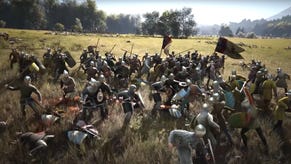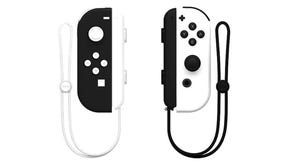Carmack says next generation is "anyone's game"
Praises Sony, doesn't like Kinect, appalled that people are targeting 30fps not 60, says digital future is inevitable.
Ever wonder what John Carmack makes of the next generation of game consoles? Speaking at QuakeCon yesterday, id Software's legendary tech wizard said, "It's anyone's game as far as I can tell right now, and that's exciting."
Over the course of another amazing three-hour keynote address, Carmack spoke about how Sony had got its s*** together for this generation, took a few swings at Kinect, talked about the inevitability of a digital future, and suggested that game development will continue in much the same vein this time around.
He began, though, by talking about how little there is to separate the PlayStation 4 and Xbox One hardware in performance terms.
"It's almost amazing how close they are in capabilities," he suggested. "How common they are and how the capabilities they give are essentially the same. We can talk about differences in memory architectures, but the bottom line being that they're a multi-core AMD processor with AMD graphics, is it's almost weird how close they are." It's "an excellent thing for AMD," he joked.
Like a lot of developers looking forward to next-gen, Carmack noted that each console's abundance of memory should be a boon. "It's going to make things a little bit easier... There's a ton more that we'll do visually to the games there," he said.
Carmack has always positioned his own game engines, including Rage's ambitious id Tech 5, at the cutting edge of what's possible with graphics technology, but this time the veteran programmer conceded that it's no longer practical to take that approach. Instead you have to pick your battles.
"I think that the writing's on the wall that pushing things to their absolute limit is not really tenable for the most part in development," he said. "There's just too much you can do... Nowadays no one person even has the entire capabilities of one of these modern platforms in their head...
"There's too much to wind up with this crystal jewel of perfection like you might have at least have deluded yourself into thinking you were approaching in previous years. So development is a lot more about trying to get the good value out of the time that you can put into it."
Carmack was clearly impressed with Sony's work to rebuild after PlayStation 3, a system about which he has been deeply critical in the past.
"Kinect is sort of like a zero-button mouse with a lot of latency on it."
"It's no secret that in the previous generation I favoured the 360 over the PS3," he reiterated. "While there are certain things Sony did well for a game developer, the 360 was a nicer platform to work on... Sony has made large strides. Their development tools came out of the gate much, much better than they ever have. They've made some somewhat-more gamer-focused decisions in their strategies and architectures."
On the Xbox One side, Carmack said he was still unconvinced by Kinect, complaining that it "still has some fundamental limitations with the latency and the frame rate".
"When you interact with Kinect, some of the standard interactions there like position and hold, and waiting for different things, it's fundamentally a poor interaction. One way that I look at it is I used to give Apple a lot of grief about the one-button mouse, when anybody working with a mouse really wants... More buttons are helpful there. And Kinect is sort of like a zero-button mouse with a lot of latency on it."
He had to pause at this point so the crowd could go, "OoooOOOOoooh!" He then resumed with an embarrassed giggle.
"Something like the PS Move where you're manoeuvring around and you've actually got buttons on it, or something like the Sixsense Razer Hydra, where you've got position-tracking but also buttons to click, I think have some fundamental advantages."
Finer-grain control will help over time, though, so it's not all doom and gloom.
"It's a technology that absolutely has a future, and Microsoft is pushing it hard, they've done a lot of excellent research with it," he said. "But I'm still not completely convinced that that's the cornerstone of the next gaming platform."
Carmack also spoke about the backlash against the Xbox One ownership and privacy policies. Although he found the strength of the public reaction "interesting", he suggested that the things Microsoft was proposing were kind of inevitable.
"One of the things that was up early before even the major issues with the used games and always-on and things like that was people being a little bit freaked out by Kinect being on all the time," he noted.
"I am completely confident that that's a very temporary vision about things, where if we go back 10 years the idea that everyone's carrying around a phone that has your GPS-located position at all times would cause a lot of the tinfoil hat crowd to go absolutely crazy - the idea that, yeah, the government's going to have backdoors into all of these, they can turn them on and track everywhere you're going. Well, yeah, that's pretty much the situation, but we just kind of carry on...
"It probably won't be many years before we wind up with SKUs that just have the optical drives deleted."
"We will just get used to it. A lot of these things are inevitable. Like, people talking about Google Glass and the issues with people carrying around having cameras recording things all the time. I think that's going to be a net positive for society, having this sort of ground truth that's retrievable in many cases in a lot of things. But it does have social transition issues that we're going to have to feel through as those are adopted."
Carmack was also unbothered by the Xbox One's game ownership policies.
"I think the witch hunt was a little bit unjustified there," he said.
"I personally am extremely fond of having all of my digital purchases in a curated garden. All of my iTunes, all of my Amazon stuff, all of my Steam things. And it's a positive thing. Yeah, you can have better and worse ways of doing that, but we are going to be very quickly past the age of having a game you hold in your hands on optical media."
"It probably won't be many years before we wind up with SKUs that just have the optical drives deleted and everybody will just be getting it through the net," he continued. "The future is obvious right there and it will be good for us in general."
All these teething issues aside, though, Carmack said he doesn't expect the way games are made to change all that much.
"Game development on there, it's not changing as much as you might think, going from previous generations. You know, we have our ways of doing things, and because it's a conventional approach that's not tearing up the rulebook, most studios are pretty much evolving the code that they've got.
"We're not throwing away our couple of million lines of code and doing something completely different. It is still using your cores to run code to generate vertexes and run fragment shaders on it, and that's not changing all that much, you just get lots more of everything. And I again think that most of the time will be spent on just making our lives easier so we can just do a better job with the games."
"It appalls me that we still have people that are targeting 30Hz games for next generation."
One thing Carmack would really like to see, though, is 60 frames-per-second adopted as the norm.
"It appalls me that we still have people that are targeting 30Hz games for next generation," he said. "It was hard to hit 60 on the current generation. There are scars in the code base and on the developers that let us make it to the quality and performance level that we did. But we've got a lot more power now, and yes you can throw it at doing some crazy pixel shader to get some final little bit of physically correct lighting onto the screen and the pixels, but it's going to be lost in the difference between non-calibrated colour in people's TVs, and I think it would just be much better for people to concentrate on smoother gameplay experiences."
With performance and process much the same, then, and technologies like Kinect still living in the margins, it's going to be close.
"The big two are clearly coming out with both barrels loaded and they're going to have a big impact," he said at one point. "It's going to be very, very interesting to see how it goes over the next couple of years - if they meet the adoption of the previous ones or if something's fundamentally changed in the market.
"Everyone would like me to come out with some A over B comparison about the two platforms, and to be completely honest I haven't done really rigorous benchmarking on them, so even if I didn't have NDA protection I couldn't give you a really completely honest answer. But they are very close, they're both very good."
And that's a good thing, he added. "I think we're always healthiest with at least a strong duopoly, if not with a full three vendors fighting it out."











